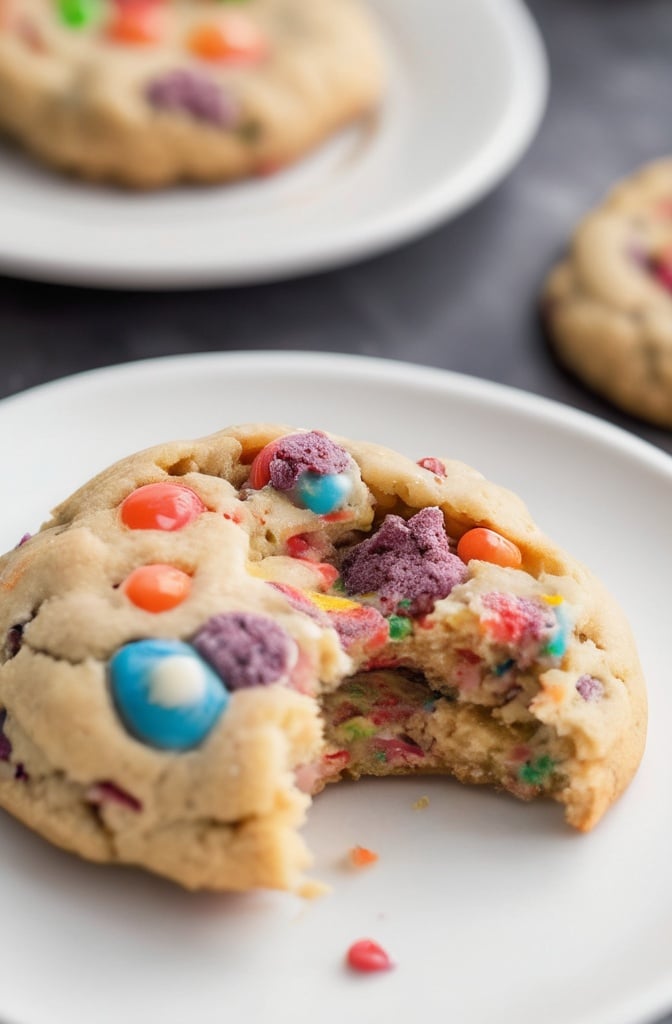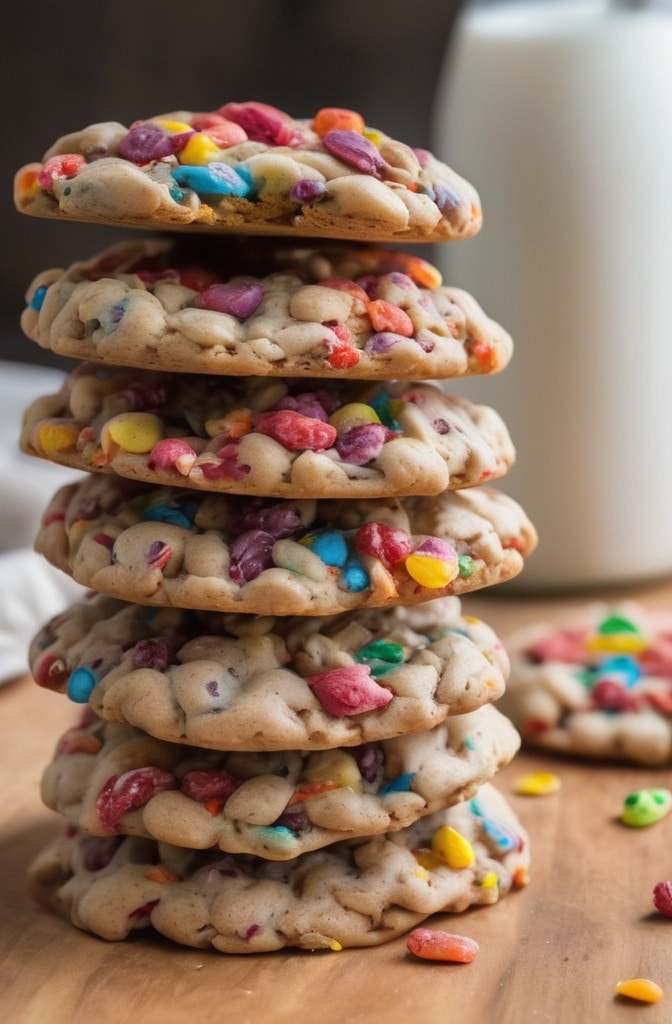Remember those Saturday mornings—bowl of colorful Fruity Pebbles in hand, cartoons playing in the background? What if I told ya those vibrant childhood memories could be transformed into the ultimate Fruity Pebbles Cookie—a soft, chewy masterpiece that’ll make your taste buds dance? As a pastry chef with two decades of cookie-making under my belt, I’ve crafted what might just be the ultimate nostalgic treat: Soft Fruity Pebbles Cookies that strike the perfect balance between childhood whimsy and refined baking technique.
I stumbled upon this recipe during a late-night baking session, trying to create something special for my niece’s birthday. The humble cereal cookie has since become my most requested recipe, appearing at celebrity events and in several upscale bakeries across the country. But don’t be intimidated—I’ve refined the technique so even novice bakers can achieve bakery-quality results.
These aren’t just any cereal cookies. The delicate balance of butter and sugar creates a soft, pillowy texture that contrasts beautifully with the slight crunch of the cereal. The colorful specks of Fruity Pebbles not only provide a visual feast but also burst with concentrated fruit flavor when baked properly. Trust me, these will dissapear faster than you can say “Yabba Dabba Doo!”
Ingredients & Substitutions
For the Cookie Base:
- 2½ cups all-purpose flour (310g)
- 1 teaspoon baking soda
- 1 teaspoon fine sea salt
- 1 cup unsalted butter, softened (226g)
- ¾ cup granulated sugar (150g)
- ¾ cup light brown sugar, packed (165g)
- 2 large eggs, room temperature
- 2 teaspoons pure vanilla extract
- 3 cups Fruity Pebbles cereal, divided (about 160g)
- Optional: ½ teaspoon almond extract
The quality of butter matters tremendously in these cookies—European-style butter with higher fat content will yield a richer, more tender cookie. For those with dairy concerns, cultured vegan butter (like Miyoko’s) works surprizingly well, though the texture becomes slightly cakier.
Gluten-free bakers can substitute a 1:1 gluten-free flour blend, but add ¼ teaspoon xanthan gum if your blend doesn’t already include it. The cereal itself is gluten-free, which is a nice bonus for those with sensitivities.
Fresh vanilla bean paste can replace extract for more pronounced vanilla notes—I’d recommend Madagascar bourbon vanilla for its fruity undertones that complement the cereal perfectly. If you’re feeling adventurous, replacing ¼ cup of the flour with freeze-dried fruit powder (strawberry or raspberry) intensifies both color and flavor profile.
Step-by-Step Instructions

Preparation
- Remove butter and eggs from the refrigerator 1 hour before beginning to ensure they reach proper room temperature. Cold ingredients are the enemy of proper cookie emulsification and can lead to dense, flat cookies—a mistake even professional bakers somtimes make.
- Preheat your oven to 350°F (175°C) and line two baking sheets with parchment paper. Never use cooking spray for cookies; the excess oil spreads into the dough and creates undesirable greasy edges.
- Pulse 1 cup of Fruity Pebbles in a food processor until finely ground into a powder. This creates a concentrated flavor base that infuses the entire dough. The remaining 2 cups will be folded in whole for texture and visual appeal.
Making the Dough
- In a medium bowl, whisk together flour, baking soda, salt, and the powdered Fruity Pebbles. Whisking dry ingredients separately ensures even distribution of leavening agents—skip this step and you might bite into a baking soda pocket. Not tasty!
- In the bowl of a stand mixer fitted with the paddle attachment (or using a hand mixer), cream together butter and both sugars on medium speed for 4-5 minutes until light and fluffy. Don’t rush this step! The incorporation of air here creates the foundation for soft cookies.
- Add eggs one at a time, beating well after each addition, followed by vanilla (and almond extract if using). The mixture might look slightly curdled—that’s perfectly normal at this stage.
- Reduce mixer speed to low and gradually add the flour mixture, mixing just until combined. Overmixing activates gluten and results in tough cookies, so stop when you still see a few streaks of flour.
- Gently fold in the remaining 2 cups of whole Fruity Pebbles using a rubber spatula. The cereal will soften slightly during baking, but maintaining whole pieces gives these cookies their signature appearance and texture bursts.
Baking and Cooling
- Scoop dough using a 3-tablespoon cookie scoop (or about 60g per cookie) onto prepared baking sheets, spacing 2 inches apart. For bakery-style cookies, press a few additional Fruity Pebbles onto the tops of each dough ball.
- Chill the cookie dough balls for 15-30 minutes before baking. This often-skipped step prevents excessive spreading and concentrates flavors. Hot ovens plus room-temperature fats equals flat cookies—cooling the dough gives structure time to set.
- Bake for 10-12 minutes until edges are just set but centers remain soft. The cookies will look underbaked—this is intentional! They’ll continue firming up while cooling. If you wait until they look completely done in the oven, they’ll end up overcooked and crunchy.
- Allow cookies to cool on the baking sheet for 5 minutes before transferring to a wire rack to cool completely. During this rest period, the residual heat continues cooking the centers to perfection.
For a variation with more complexity, try browning half the butter before creaming. This adds nutty, caramel notes that beautifully complement the fruity flavors. Just be sure to chill the browned butter back to room temperature solidity before proceeding.
Cooking Techniques & Science
The magic of these Fruity Pebbles cookies lies in understanding the science behind their texture. The cereal serves dual purposes: ground Fruity Pebbles act as part of the dry ingredients, absorbing moisture and providing flavor, while the whole pieces create pockets of texture and concentrated fruit essence.
Unlike traditional cereal cookies that often end up crunchy, these maintain softness through precise fat-to-sugar ratios. The brown sugar provides hygroscopic properties—meaning it attracts and retains moisture—which keeps these cookies soft for days. Underbaking slightly (pulling them when the centers still look wet but edges are set) ensures they stay tender rather than crunchy.
The cereal itself undergoes a fascinating transformation during baking. The sugary coating melts slightly, creating tiny caramelized pockets throughout the cookie. This process, known as the Maillard reaction, develops complex flavor compounds beyond what either the dough or cereal could achieve independently.
Temperature control is crucial throughout the process. Room temperature ingredients create a proper emulsion that traps air during creaming, while chilled dough before baking prevents premature spreading. Many bakers don’t realize that dough temperature is as important as oven temperature—the sweet spot is around 68°F (20°C) when the dough hits the oven.
For those using convection ovens, reduce temperature by 25°F and watch carefully as bake times may decrease by 1-2 minutes. The circulating air encourages more even browning but can dry the cookies if not monitored.
Serving & Pairing Suggestions
These vibrant cookies deserve an equally thoughtful presentation. Serve them slightly warm (10 seconds in the microwave) to reactivate the buttery softness and intensify the fruity aroma. The colors pop beautifully against white serving plates or vintage milk glass platters.
For an elevated dessert experience, sandwich premium vanilla bean ice cream between two cookies and roll the edges in extra crushed Fruity Pebbles. Let them firm up in the freezer for 30 minutes before serving—a show-stopping dessert that balances temperatures and textures.
Coffee pairings should avoid dark roasts which might overwhelm the delicate fruit notes. Instead, opt for a medium roast with citrus undertones or a vanilla-infused cold brew. For tea enthusiasts, a light bergamot Earl Grey or fruity herbal blend complements without competing.
Kids love these alongside a glass of cold milk, but adults might appreciate them with a dessert wine like Moscato d’Asti or even a fruity lambic beer. The slight acidity in these beverages cuts through the sweetness while enhancing the fruity aspects.
For a truly memorable experience, serve these as part of a nostalgic dessert board featuring other childhood favorites reimagined: mini rice krispie treats, chocolate pudding shots with malt ball crumbles, or homemade pop-tarts. The combination creates a sophisticated play on saturday morning classics.
Storage and Make-Ahead Tips

These cookies maintain optimal texture for 3-4 days when stored in an airtight container at room temperature with a slice of bread (the bread sacrifices its moisture to keep the cookies soft). For longer storage, freeze baked cookies for up to 3 months.
The raw dough freezes beautifully—portion into balls, freeze solid on a sheet pan, then transfer to freezer bags. Bake straight from frozen, adding just 2 minutes to the bake time. Having ready-to-bake cookie dough in your freezer is like having money in the bank for last-minute entertaining.
Conclusion
The humble Fruity Pebbles cookie represents the perfect intersection of nostalgic comfort and sophisticated baking technique. By understanding the role each ingredient plays—from the hygroscopic properties of brown sugar to the dual functionality of processed and whole cereal pieces—you can create cookies that transcend their simple origins.
What makes these cookies truly special isn’t just their vibrant appearance or flavor profile, but their ability to connect generations through shared food memories. They demonstrate that playful ingredients can be elevated through proper technique without losing their essential character.
Whether you’re baking these for a special occasion, weekend treats, or professional applications, remember that the difference between good and exceptional cookies often comes down to small details: proper ingredient temperature, adequate creaming time, and the courage to pull them from the oven when they still look slightly underdone.
Master this recipe, and you’ll have a signature treat that delights both the eye and the palate—proof that sometimes the most sophisticated culinary experiences come from embracing our most colorful childhood memories.
FAQs About Fruity Pebbles Cookie
Why did my Fruity Pebbles lose their color during baking?
Excessive moisture or prolonged exposure to heat can cause the cereal’s colors to bleed. Make sure your dough isn’t too wet, and don’t overbake. Adding some cereal on top right before baking helps maintain vivid colors for presentation.
Can I make these cookies ahead of time for a party?
Absolutely! Either freeze portioned dough balls to bake fresh the day of your event, or bake them 1-2 days ahead and store in an airtight container with a slice of bread to maintain moisture. A quick 8-10 second reheat in the microwave will refresh them beautifully.
How can I make these cookies more colorful for special occasions?
For extra vibrancy, fold in 2-3 tablespoons of similarly flavored sprinkles along with the cereal, or press additional cereal pieces onto the tops before baking. For themed events, coordinate with seasonal Fruity Pebbles limited editions or add complementary colored white chocolate chips.
My cookies spread too much and became thin. What went wrong?
Three likely culprits: butter was too warm, insufficient chilling time, or too little flour. Make sure your butter is cool room temperature (should dent when pressed, not slump), chill the dough balls for at least 15 minutes, and measure flour accurately using a scale if possible.
Can I use other cereals instead of Fruity Pebbles?
Yes! This recipe works beautifully with Cocoa Pebbles for a chocolate version, or try Cap’n Crunch, Cinnamon Toast Crunch, or Lucky Charms for different flavor profiles. Each cereal absorbs moisture differently, so you may need to adjust flour by 2-3 tablespoons to maintain proper dough consistency.

